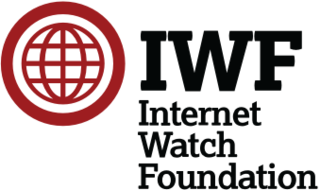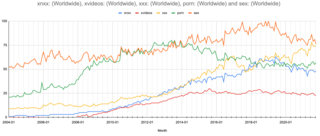Related Research Articles

Pornography laws by region vary throughout the world. The production and distribution of pornographic films are both activities that are lawful in many, but by no means in all countries so long as the pornography features performers aged above a certain age, usually 18 years. Further restrictions are often placed on such material.
Rape pornography is a subgenre of pornography involving the description or depiction of rape. Such pornography either involves simulated rape, wherein sexually consenting adults feign rape, or it involves actual rape. Victims of actual rape may be coerced to feign consent such that the pornography produced deceptively appears as simulated rape or non-rape pornography. The depiction of rape in non-pornographic media is not considered rape pornography. Simulated scenes of rape and other forms of sexual violence have appeared in mainstream cinema, including rape and revenge films, almost since its advent.

Sexual grooming refers to actions or behaviors used to establish an emotional connection with a minor, and sometimes the child's family, to lower the child's inhibitions with the objective of sexual abuse. It can occur in various settings, including online, in person, and through other means of communication. Children who are groomed may experience mental health issues, including "anxiety, depression, post-traumatic stress, and suicidal thoughts."

Pornography has been dominated by a few pan-European producers and distributors, the most notable of which is the Private Media Group that successfully claimed the position previously held by Color Climax Corporation in the early 1990s. Most European countries also have local pornography producers, from Portugal to Serbia, who face varying levels of competition with international producers. The legal status of pornography varies widely in Europe; its production and distribution are illegal in countries such as Ukraine, Belarus and Bulgaria, while Hungary has liberal pornography laws.
The International Centre for Missing & Exploited Children (ICMEC), headquartered in Alexandria, Virginia, with a regional presence in Brazil, Singapore, and Australia, is a private 501(c)(3) non-governmental, nonprofit global organization. It combats child sexual exploitation, child pornography, and child abduction.
Child erotica is non-pornographic material relating to children that is used by any individuals for sexual purposes. It is a broader term than child pornography, incorporating material that may cause sexual arousal such as nonsexual images, books or magazines on children or pedophilia, toys, diaries, or clothes. Law enforcement investigators have found that child erotica is often collected by pedophiles and child sexual abuse offenders. It may be collected as a form of compulsive behavior and as a substitute for illegal underage pornography and is often a form of evidence for criminal behavior.

The Internet Watch Foundation (IWF) is a global registered charity based in Cambridge, England. It states that its remit is "to minimise the availability of online sexual abuse content, specifically child sexual abuse images and videos hosted anywhere in the world and non-photographic child sexual abuse images hosted in the UK." Content inciting racial hatred was removed from the IWF's remit after a police website was set up for the purpose in April 2011. The IWF used to also take reports of criminally obscene adult content hosted in the UK. This was removed from the IWF's remit in 2017. As part of its function, the IWF says that it will "supply partners with an accurate and current URL list to enable blocking of child sexual abuse content". It has "an excellent and responsive national Hotline reporting service" for receiving reports from the public. In addition to receiving referrals from the public, its agents also proactively search the open web and deep web to identify child sexual abuse images and videos. It can then ask service providers to take down the websites containing the images or to block them if they fall outside UK jurisdiction.
Legal frameworks around fictional pornography depicting minors vary depending on country and nature of the material involved. Laws against production, distribution and consumption of child pornography generally separate images into three categories: real, pseudo, and virtual. Pseudo-photographic child pornography is produced by digitally manipulating non-sexual images of real minors to make pornographic material. Virtual child pornography depicts purely fictional characters. "Fictional pornography depicting minors", as covered in this article, includes these latter two categories, whose legalities vary by jurisdiction, and often differ with each other and with the legality of real child pornography.

Internet pornography is any pornography that is accessible over the internet; primarily via websites, FTP connections, peer-to-peer file sharing, or Usenet newsgroups. The greater accessibility of the World Wide Web from the late 1990s led to an incremental growth of internet pornography, the use of which among adolescents and adults has since become increasingly popular.
In the United States, child pornography is illegal under federal law and in all states and is punishable by up to life imprisonment and fines of up to $250,000. U.S. laws regarding child pornography are virtually always enforced and amongst the harshest in the world. The Supreme Court of the United States has found child pornography to be outside the protections of the First Amendment to the United States Constitution. Federal sentencing guidelines on child pornography differentiate between production, distribution, and purchasing/receiving, and also include variations in severity based on the age of the child involved in the materials, with significant increases in penalties when the offense involves a prepubescent child or a child under the age of 18. U.S. law distinguishes between pornographic images of an actual minor, realistic images that are not of an actual minor, and non-realistic images such as drawings. The latter two categories are legally protected unless found to be obscene, whereas the first does not require a finding of obscenity.
Simulated child pornography is child pornography depicting what appear to be minors but which is produced without their direct involvement.
The Canadian law forbids the production, distribution, and possession of child pornography, which are punishable by up to 20 years' imprisonment or a fine of $5,000.
The production, sale, distribution, and commercialization of child pornography in Japan is illegal under the Act on Punishment of Activities Relating to Child Prostitution and Child Pornography, and the Protection of Children (1999), and is punishable by a maximum penalty of five years in prison and/or a fine of ¥5,000,000. Simple possession of child pornography was made illegal by an amendment to the act in 2014. Virtual child pornography, which depicts wholly-fictional characters, is legal to produce and possess.
The Australian law prohibits all sexual depictions of children under an age set by state and territory legislation. The relevant ages are under 16 in the Australian Capital Territory, New South Wales, Queensland and Western Australia, under 17 in South Australia, and under 18 in the other jurisdictions and under federal law. The laws covering child pornography are differently defined in the various Australian jurisdictions, as are the penalties. The laws also cover depictions of sexual acts involving people over the threshold age who are simulating or otherwise alluding to being underage, even if all those involved are of a legal age. People have been successfully prosecuted after describing acts of abuse via MMS.
Child pornography is illegal in most countries, but there is substantial variation in definitions, categories, penalties, and interpretations of laws. Differences include the definition of "child" under the laws, which can vary with the age of sexual consent; the definition of "child pornography" itself, for example on the basis of medium or degree of reality; and which actions are criminal. Laws surrounding fictional child pornography are a major source of variation between jurisdictions; some maintain distinctions in legality between real and fictive pornography depicting minors, while others regulate fictive material under general laws against child pornography.
Child pornography is unlawful pornography in most jurisdictions that exploits minors for sexual stimulation. It may be produced with the direct involvement or sexual assault of a child or it may be simulated child pornography. Abuse of the child occurs during the sexual acts or lascivious exhibitions of genitals or pubic areas which are recorded in the production of child pornography. Child pornography may use a variety of mediums, including writings, magazines, photos, sculpture, drawing, painting, animation, sound recording, video, virtual reality and video games. Child pornography may be created for profit or other reasons.

Pornography in Pakistan is subject to several legal provisions. The Government of Pakistan has placed ban on internet websites containing such material since November 2011. Major pornography website are already barred in Pakistan. In 2016, it was reported that government of Pakistan ordered Internet Service Providers (ISPs) in Pakistan to block more than 400,000 websites which contained pornographic content. Later in 2019, around 800,000 additional website containing pornographic content were banned by the Pakistan Telecom Authority on the order of government of Pakistan.
Johannes Cornelis Christiaan "Joop" Wilhelmus was a Dutch pornographer and entrepreneur, known for co-founding and publishing pornographic magazine Chick, founding and publishing child pornography magazine Lolita, and for pedophile advocacy.

Pornography in the Netherlands has been legal since 1985.

Cybersex trafficking, live streaming sexual abuse, webcam sex tourism/abuse or ICTs -facilitated sexual exploitation is a cybercrime involving sex trafficking and the live streaming of coerced sexual acts and/or rape on webcam.
References
- 1 2 "Wetboek-online.nl | Pagina niet gevonden".
- ↑ Dutch Senate (2 July 1985). "Dutch Senate referencing the Chick-arrest" (in Dutch). Staten-Generaal Digitaal. Retrieved 21 December 2014.
- ↑ Howitt, Dennis; Sheldon, Kerry (2007). Sex Offenders and the Internet . John Wiley & Sons. p. 75. ISBN 978-0-470-02800-1.
- ↑ Beetstra, Tjalling (2009). Van kwaad tot erger. De sociale constructie van satanisch ritueel misbruik in de Verenigde Staten en Nederland[From Bad to Worse. The Social Construction of Satanic Ritual Abuse in the United States and the Netherlands] (Thesis) (in Dutch). Datawyse/Universitaire Pers Maastricht.
- ↑ Van der Ploeg, Jan; De Groot, Roel, eds. (2010). "6.4 Is pedoseksualiteit schadelijk?" [6.4 Is Pedosexuality Harmful?]. Kindermishandeling: een complex probleem[Child Abuse: A Complex Problem] (in Dutch). Antwerpen: Garant. p. 110. ISBN 9789044125771.
- ↑ Tate, Tim (1990). Child Pornography: An Investigation. Methuen Publishing. p. 60. ISBN 978-0-413-61540-4.
- ↑ Schuijer, Jan; Rossen, Benjamin (1992). "The Trade in Child Pornography". IPT Journal. Institute for Psychological Therapies. 4. Retrieved 18 December 2009.
- ↑ Justitie (1 October 2002). Retrieved January 20, 2006. Archived April 19, 2006, at the Wayback Machine
- ↑ Libbenga, Jan (21 February 2007). "Dutch demand ban of virtual child porn in Second Life". The Register . Retrieved 18 December 2009.
- ↑ "Virtual child porn may be a crime in Netherlands". Reuters . 21 February 2007. Retrieved 18 December 2009.
- ↑ "Explosive rise in child porn websites". DutchNews.nl . 11 April 2008. Retrieved 18 December 2009.
- ↑ "Increased amount of child sexual abuse material detected in Europe". ec.europa.eu. Retrieved 2022-03-12.